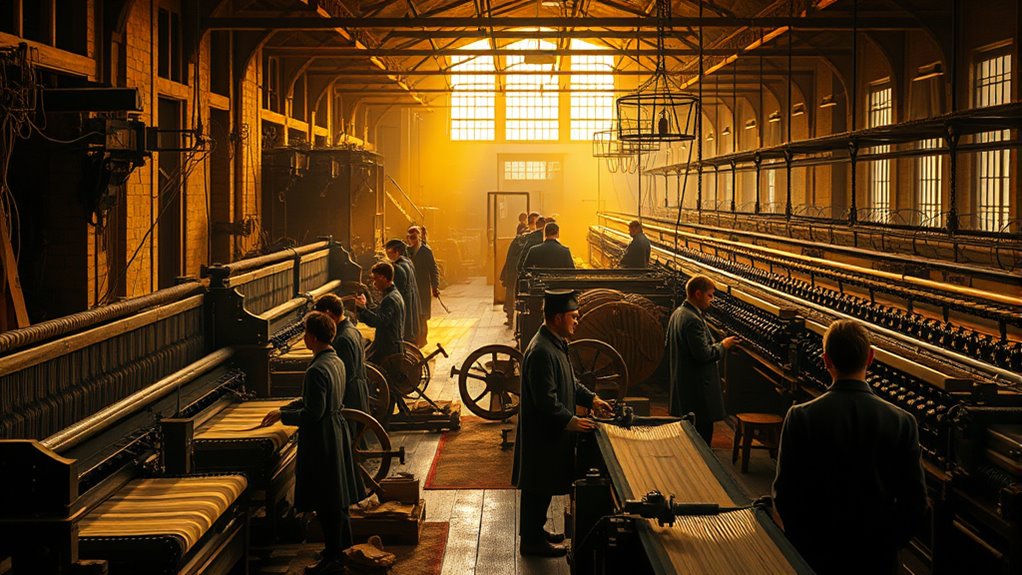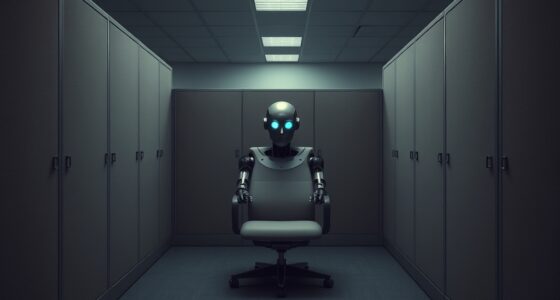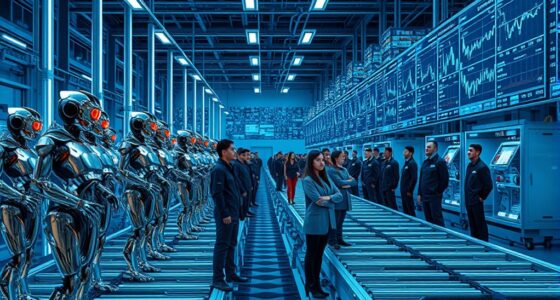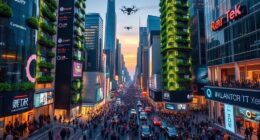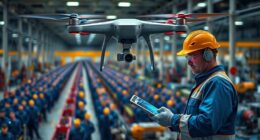Throughout history, technology has continually changed how work and wealth are organized. Starting with the Luddite protests against machines in the early 1800s, society faced fears of job loss and inequality. The Industrial Revolution then brought new industries and economic growth but also disparities. Today, AI and automation displace jobs again, forcing society to adapt and reskill. If you explore further, you’ll see how these patterns shape our future and what you can do about them.
Key Takeaways
- Historically, technological advances like the Industrial Revolution displaced workers but also created new industries and increased overall wealth.
- The Luddite movement arose as a reaction to mechanization threatening jobs, reflecting early resistance to technological change.
- Modern AI and automation continue this pattern, transforming industries, displacing jobs, and prompting workforce reskilling efforts.
- Technological progress shifts wealth from labor to capital, often increasing inequality and sparking social and economic tensions.
- Ensuring equitable access and ethical development of technology is vital to prevent societal disparities and promote shared prosperity.
The Origins of Resistance: The Luddite Movement

The Luddite movement began in 1811 amid difficult economic conditions caused by the Napoleonic Wars. You’re living through high unemployment, inflation, and food shortages, especially during the winter of 1810-1811. Napoleon’s Continental System worsens trade issues, hitting workers hard. Factory conditions are poor, with no safety standards or medical care, fueling frustration. Originating in Arnold, Nottinghamshire, the movement quickly spreads to Yorkshire and Lancashire, targeting machinery like shearing frames and power looms that threaten skilled jobs. Disgruntled workers—many women and children—organized night drills, attacking factories to destroy machinery. They sent threatening letters to employers, demanding changes. Their actions reflect deep resistance to losing livelihoods amid economic turmoil and industrial change, marking a pivotal moment in labor history. Additionally, the movement’s use of destruction as a form of protest echoes earlier traditions of artistic influence and symbolic expression in cultural resistance.
Industrial Revolution: Transforming Economies and Societies
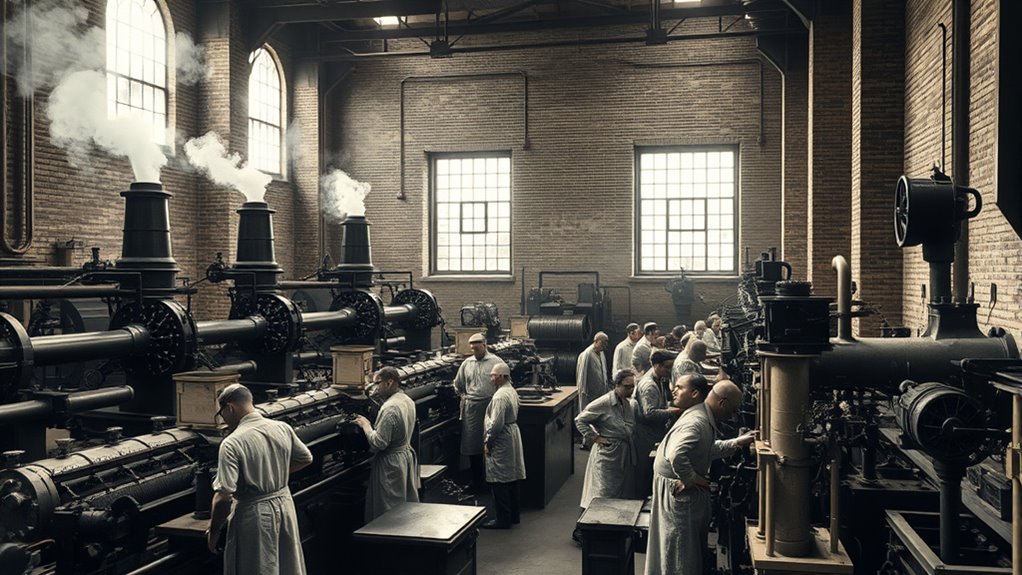
As the Industrial Revolution gained momentum, economies transformed rapidly, reshaping how goods were produced and consumed. You’d notice increased efficiency through machines, which lowered costs and boosted output. New industries emerged, creating diverse jobs beyond agriculture and raising incomes—from $400 in 1760 to $800 in 1860 in Britain. Wealth grew overall, though disparities remained. Governments used tariffs to protect industries, fueling infrastructure like railroads. Societal changes followed: people moved to cities for work, leading to urban growth and new social classes. Living standards improved with cheaper goods, but working conditions were initially tough. Cities became hubs of activity, and innovations like steam engines and telegraphs revolutionized transportation and communication, shaping a more interconnected economy and society. Economic growth during this period was driven by technological innovations, which significantly increased productivity and living standards over time. Additionally, these advancements laid the groundwork for the modern digital economy that continues to evolve today. The adoption of sustainable practices in industries, such as organic farming, foreshadowed future shifts towards environmentally conscious growth. The revolutionary impact of these innovations also encouraged ongoing technological advancements, which continue to influence modern industries and societal structures. Moreover, the integration of AI and automation in production processes has further accelerated efficiency and innovation, building on the technological foundations of the Industrial Revolution. Furthermore, the development of early home entertainment technology, such as projectors and audio systems, reflected the expanding scope of technological influence beyond industrial applications.
The Rise of Machines: Displacement and Economic Shifts
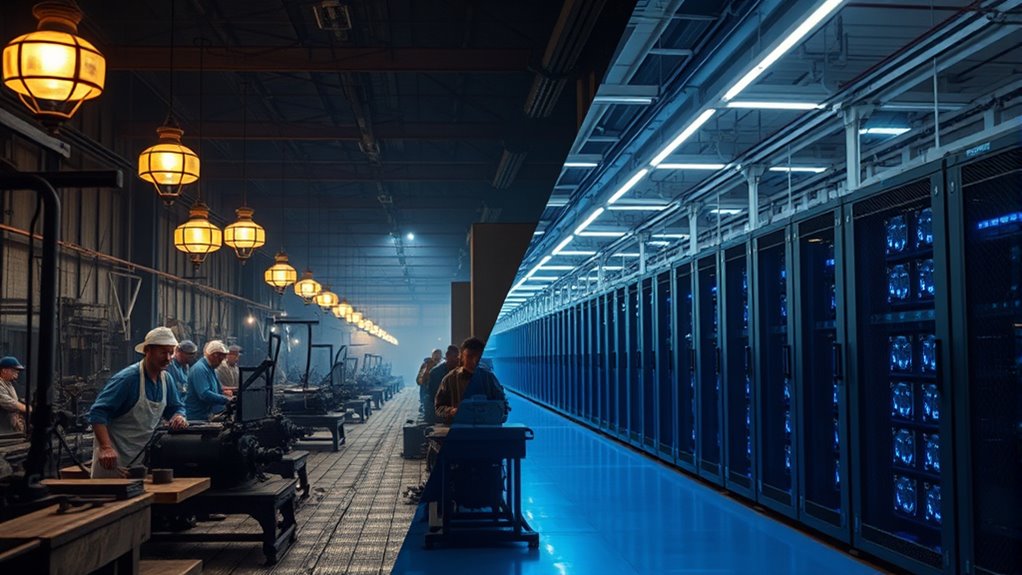
Automation and AI are rapidly reshaping the workforce, causing widespread displacement of jobs across industries. Nearly half of U.S. workers—about 12.6%—face high risk of losing their jobs in the next decade, with global displacement already impacting 14% of workers. By 2030, robots and autonomous systems are expected to displace 5 million jobs worldwide, especially in energy, utilities, and mining sectors, where over 46.5% of roles are vulnerable. Machines now perform around 34% of business tasks, transforming roles in manual and repetitive work. As automation accelerates—with industrial robot shipments rising—there’s a growing push for reskilling, with 77% of employers planning to train employees to work alongside AI. Additionally, AI-driven platforms are contributing to the transformation of industries by providing customized and innovative solutions. These shifts are marked by a steady, ongoing transformation of the global job landscape, driven by the increasing integration of ethical hacking practices to secure automated systems.
Technology’s Role in Modern Society: AI and Automation
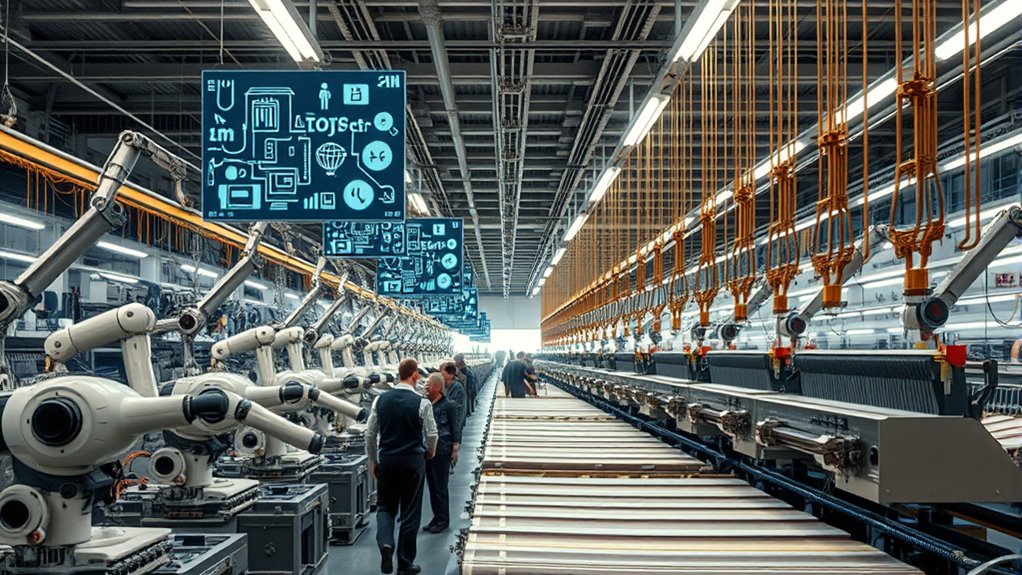
AI and automation are fundamentally transforming modern society by reshaping industries, redefining work, and influencing daily life. Today, 78% of organizations use AI—up from 20% in 2017—impacting healthcare, finance, and transportation. Generative AI now enhances complex, creative tasks, while automation boosts efficiency across sectors. These changes mean you’ll need new skills to stay relevant, as AI influences job roles and workflows. Incorporating workplace automation strategies can help organizations adapt more effectively. Additionally, adopting organizational decluttering methods can streamline processes and improve overall productivity in the evolving workplace. Ensuring the trustworthiness and safety of AI systems, such as GPT-4, is crucial as reliance on these technologies grows, highlighting the importance of AI safety measures.
Adapting the Workforce: Skills and Education for the Future
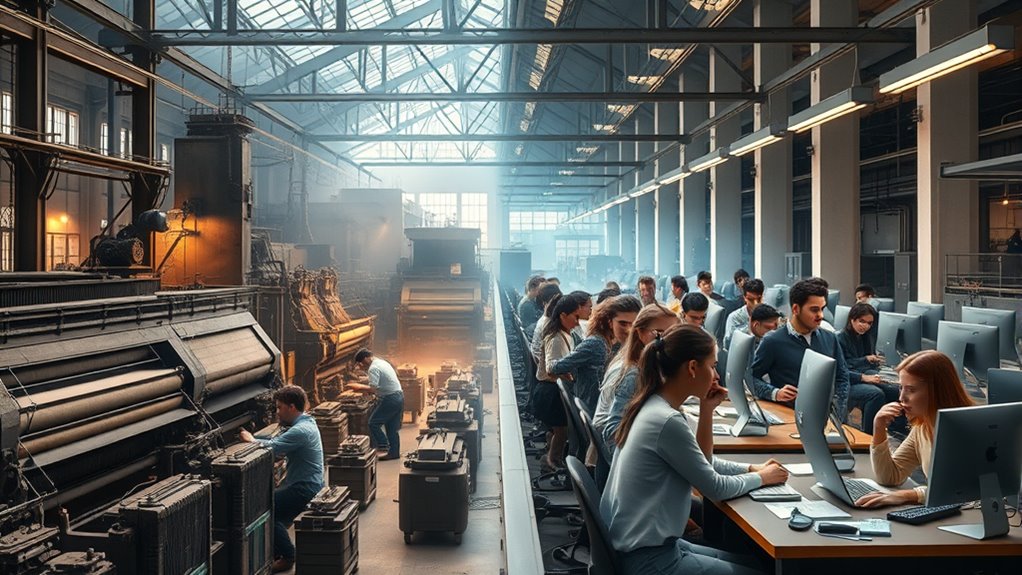
The rapid integration of AI and automation into various industries means your skills must keep pace with technological advances. To stay relevant, you need to focus on continuous learning, adapting to evolving demands, and developing new competencies. Employers increasingly value digital literacy, AI expertise, and leadership skills to navigate future challenges. Reskilling and upskilling programs are vital for aligning your abilities with shifting job requirements. Major Drivers Shaping the Labour Market indicate that technological change will continue to accelerate, making ongoing skill development essential for future success. Embracing lifelong learning to keep up with rapid change is crucial, as is cultivating durable skills like emotional intelligence and adaptability. Incorporating creative practice into your skill set can foster innovative thinking and problem-solving abilities that are highly valued in the evolving job landscape. Additionally, understanding the Law of Attraction can help individuals cultivate a positive mindset and attract opportunities for growth and innovation. Partner with educational institutions and leverage employer training initiatives.
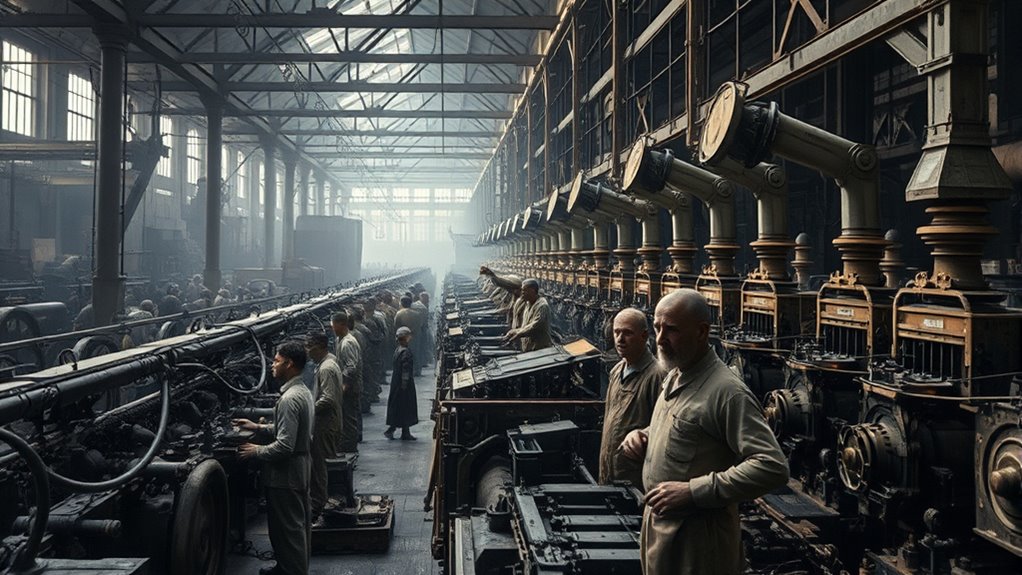
Throughout history, technological advancements have often sparked social unrest and widened economic disparities. During the Industrial Revolution, workers protested machinery, fearing job losses, while wealth concentrated among owners. Early tech shifts favored the wealthy, creating lasting inequality. Today, automation and AI threaten to displace many jobs, fueling fears of increased income gaps. The demand for skilled workers deepens educational divides, and many worry that AI will intensify social polarization. Public perception reflects these concerns, with half of Americans believing AI would worsen inequality. Technological progress also shifts income from labor to capital, exacerbating disparities both within countries and globally. As history shows, technological change often triggers social unrest, underscoring the need to address inequality to prevent instability. Understanding the role of sound design and related technological innovations highlights how technological shifts can influence societal structures and cultural perceptions, further emphasizing the importance of equitable technological development. Additionally, initiatives like hackathons, especially those focused on innovation and collaboration, can serve as platforms to foster inclusive solutions for technological challenges, promoting broader societal benefits. Recognizing the importance of equitable access to technology is crucial in mitigating social unrest and ensuring that advancements benefit all sections of society, especially as wealth concentration continues to grow among a small elite. Furthermore, historical patterns demonstrate how technological disparities can lead to social tensions if not properly managed, making proactive policies essential.
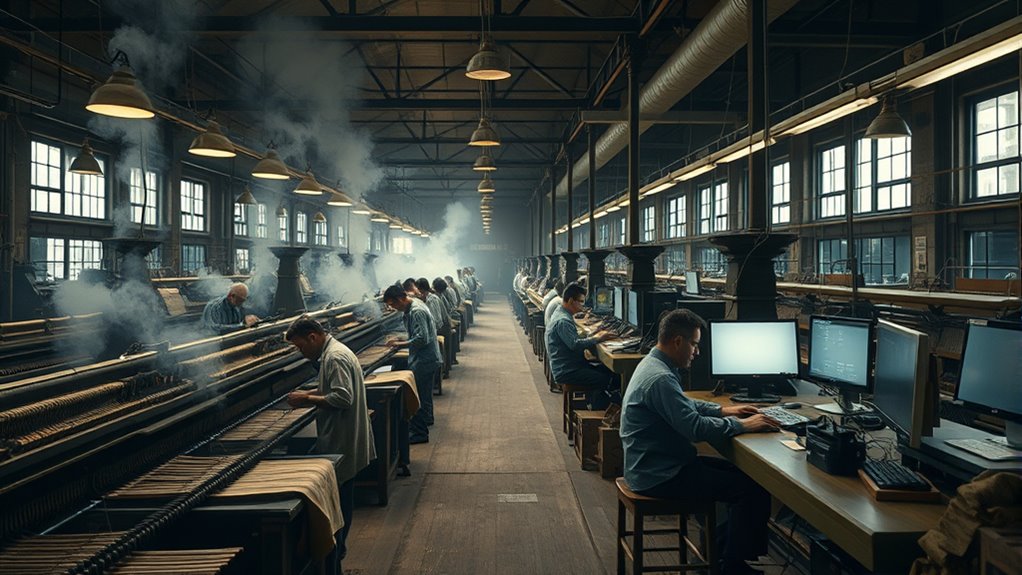
As technological advancements continue to reshape society, embracing change becomes essential for staying competitive in the evolving world of work. You need to adapt quickly to leverage digital transformation, AI, and automation that are transforming industries. Skills like AI literacy and data analytics are increasingly valuable, and your ability to learn new skills will determine your career trajectory. The workforce is shifting toward remote and flexible work, making adaptability more critical than ever. To stay ahead, focus on:
- Developing new skills through personalized learning
- Embracing flexible work arrangements
- Staying open to reskilling and upskilling opportunities
- Proper storage of digital tools and resources ensures their longevity and security. Incorporating data security best practices can help protect sensitive information in a rapidly changing technological landscape. Additionally, understanding sound healing science can inspire innovative ways to promote well-being and resilience in the workplace.
Frequently Asked Questions
How Did Early Industrial Protests Influence Modern Labor Rights?
Your question about early industrial protests shows how they shaped modern labor rights. You see, these protests highlighted the clash between technological progress and workers’ protections. They pushed for better labor standards and inspired unions. The fierce government pushback made workers realize the need for legal safeguards. Today, their legacy lives on in labor laws and activism, reminding us that protecting workers’ rights is vital during times of change.
What Lessons From the Luddites Apply to Today’S AI Debates?
Remember, history repeats itself. When you look at Luddites’ resistance to machinery, you see parallels with today’s AI debates. Just as they feared job loss, you should recognize that embracing change means adapting and developing new skills. Learning from the Luddites, you realize that regulation, education, and ethical considerations are essential. You can shape a future where technology benefits everyone, rather than leaving workers behind.
How Has Technology Historically Affected Global Economic Disparities?
You see, technology has historically widened economic disparities by increasing the value of skilled labor and capital, often benefiting the wealthy while displacing lower-skilled workers. As new innovations emerge, they tend to concentrate wealth among those who control capital or possess high-level skills, deepening inequality both within and across countries. Over time, this pattern shows how technological progress can reinforce social power structures and economic divides.
What Roles Do Governments Play in Managing Technological Unemployment?
You see, governments play a vital role in managing technological unemployment by implementing programs like retraining, income support, and relocation assistance. They establish policies to help displaced workers adapt, such as public works projects and education initiatives. Additionally, they use data-driven strategies and foster public-private partnerships to create new job opportunities, ensuring workers stay resilient in changing tech landscapes and reducing economic disparities caused by automation and innovation.
Can Societal Adaptation Keep Pace With Rapid Technological Change?
You wonder if society can keep up with rapid technological change. It’s challenging but possible if you focus on strengthening skills, updating policies, and investing in research. Governments, businesses, and individuals need to collaborate and be proactive. By prioritizing inclusive growth and ethical considerations, you can help guarantee that advancements benefit everyone, reducing inequalities and fostering sustainable development. Staying adaptable is key to steering through these swift innovations.
Conclusion
As you stand on the brink of tomorrow, remember that every leap in technology has reshaped your world in ways you can’t imagine. From the Luddites to AI, it’s like riding an unstoppable rollercoaster—thrilling, terrifying, and endlessly transformative. Embrace the chaos, adapt faster than ever, and know that your ability to evolve determines whether you’re left behind or leading the charge into a future so bright it might just blind you.
